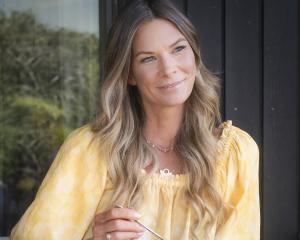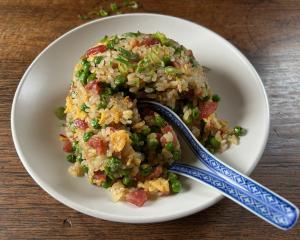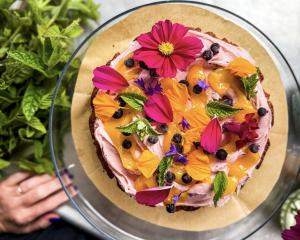Alan Brady describes himself as a dreamer, but when he and former wife Denise planted grapes on their small plot of land in Gibbston 30 years ago, they certainly didn't dream their modest vineyard would lead to the development of an industry in the region that would become known around the world for its wines.
"The whole romantic idea of having a vineyard and making wine and selling it on site really was a very seductive proposition for both of us at the time," he said.
He tells the story in Pinot Central: A winemaker's story, an honest and very readable book.
It's a personal story of escape from the city rat-race and a demanding career in television, restoring a stone ruin to first a holiday then a permanent house, finding ways to make a living in the country, looking for various uses for their small plot of land, and eventually becoming obsessed with growing and making wine - at personal as well as financial expense.
He chronicles the trials and tribulations, disappointments and celebrations that ultimately confounded the many doubters who said you couldn't produce wine in the Deep South.
He did, of course, and founded three wine companies - Gibbston Valley Wines, Mount Edward, and Wild Irishman - downsizing each time they grew too big for him to be as hands-on as he desired to be.
Often referred to as the Godfather of Central Otago wine, Brady has a background as a journalist that enabled him to "brazenly use all my media experience to promote the region and my own wines.
I suspect that rarely in the history of the wine industry has so little wine received so much publicity", he writes.
Sometimes this self-generated publicity embarrasses him, he says.
He is the first to point out that he was only one of the wine-growing pioneers of the region in the late 1970s and early 1980s.
Rolfe and Lois Mills, of Rippon, Ann Pinckney, of Taramea, Verdun Burgess and Sue Edwards, of Black Ridge, and Bill and Gill Grant, of William Hill, were planting grapes around the same time.
"We were the world's southernmost grape growers - and we still are, but we felt it very much in those early days. We felt our isolation, but in the end - and I've said this a number of times, isolation became one of our great strengths in Central Otago because we learned to work together, sharing ideas and equipment and knowledge and celebrating our success and crying over our disasters together.
And it was very much together we learned to unlock the secrets of growing grapes in this fantastic place.
Today, our reputation and our passion for this life has grown and we continue to learn, but we no longer feel isolated down here at the bottom of the wine world. That's the big change.
We're very much part of the greater fraternity now and the world knows about us in a way that I couldn't have envisaged when I planted my first grapes 30 years ago," he said.
He also points out that during those 30 years the modern New Zealand wine industry was developing into an international force in the wine world, and Central Otago was part of that.
Brady, who arrived in New Zealand from Ireland 50 years ago, says he comes from a family of wanderers.
He grew up on tales of the travels and adventures of his great-grandfather, grandfather and father.
Even in New Zealand he had a history of moving from place to place and house to house - although he has lived in the Gibbston-Queenstown area for longer than anywhere else and now gets homesick for it when travelling.
"There is something particular about the environment here. The energy in these mountains is very strong for me and I think it's that magic that attracts so many people to this area," he says.
He blames aspects of his restlessness on his 30-year career as a journalist.
"Every day you have a new assignment and the old one's forgotten. Whatever the project is, it's over and done with and it's all the excitement of what's coming next. That has left me with a very short attention span and as a result I need new things all the time to keep me alive."
Working with the seasonal cycle of the vines and wine - pruning, cultivating, managing growth, thinning fruit, harvesting, making wine, marketing, and starting over again - has slowed him down somewhat, although within that cycle, he still looks for new projects as he completes old ones, he says.
"I believe before I start out on any project I have to have a clear vision of the completed object. If it's a building, a vineyard or a scheme, I really need to be able to see it clearly, to visualise it, and if I do - I think anyone can make things happen if they have a clear dream and stick with it."
The original dream of a small vineyard and selling wine from the gate grew into a vision of a purpose-built winery and restaurant, something he was not able to achieve on his own.
His vision attracted investors, and Gibbston Valley Wines opened in December 1990 with its winery and restaurant (only the fourth winery restaurant in the South Island), and five years later, the cave and barrel store were added.
However, the company grew and Brady yearned to get back to hands-on involvement with grape-growing and wine-making.
At the age of 61, it was time to move on again, he says.
He had a small vineyard and plot of land nearby and this became the basis for establishing Mount Edward as a one-man business - he even lived in the small winery - which focused on export, getting his wines into some of the most prestigious London restaurants.
However, Mount Edward grew too, and he was under pressure to expand, which he was reluctant to do.
"Then, in another of those 'doorway moments' that have marked my career, a young winemaker whom I had known for years called by to ask if I would be interested in merging with his operation," he writes.
And so Duncan Forsyth, his wife Helen and partner John Buchanan became the major shareholders of Mount Edward and expanded the business.
Nevertheless, Brady was not about to relinquish his passion for the annual ritual of turning grapes into wine.
Now, at 74, he makes and markets Wild Irishman, 10 barrels of pinot noir a year from two small sites, one at Bannockburn and one in Gibbston.
Because he tends to live in the present and the future, writing his memoir and delving into the past was a difficult, if interesting experience, he says.
The wines themselves - original bottles stored in the Gibbston Valley wine library, which he showed visitors recently - reflect the past 30 years better than anything he can write about, he says.
"They tell the story of 30 years of grape-growing and wine-making, our journey from zero to hero, really. Some of them are good; some of them are awful; some of them were judged the best in the world, but certainly for me they are old friends, and seeing them again revived memories of good times and bad."
The book
Pinot Central: A winemaker's story by Alan Brady, with photographs by Dale Gardiner, is published by Penguin ($67).











